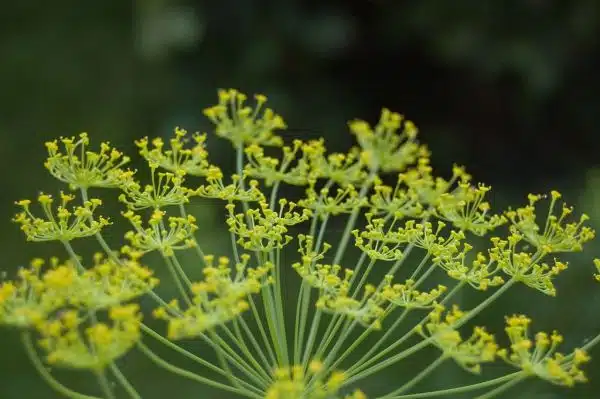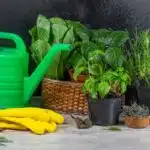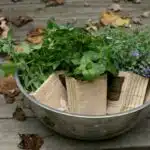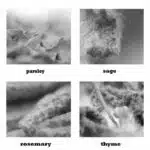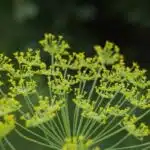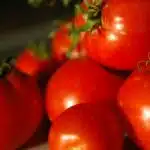As winter approaches, many gardeners face the challenge of keeping their herbs alive. The harsh weather conditions and shorter daylight hours can take a toll on these delicate plants, making it difficult to maintain their health and vitality. As a horticulturalist, I have encountered this problem numerous times and have developed effective strategies to help keep herbs thriving throughout the winter season.
To ensure that your herbs survive during winter, it is important to understand the unique needs of each plant species. Some herbs are hardier than others and can withstand colder temperatures, while others require more protection from frost and wind. Additionally, factors such as soil quality, watering frequency, and lighting conditions can also impact the health of your herbs. By taking a thoughtful approach to caring for your plants during the winter months, you can help them thrive and continue to provide fresh flavors and aromas all year round.
Understanding Your Herbs’ Needs
Growing herbs in the winter months can be a challenging task. However, with the right knowledge and techniques, you can keep your herbs alive all year round. Herbs in containers need special care as they are more vulnerable to environmental changes than those grown directly in the soil. Choosing the right type of container is crucial for the survival of your plants.
Soil requirements are critical for herb growth as they provide essential nutrients and moisture. The soil should be well-draining, rich in organic matter, and have a pH level between 6.0 and 7.5. It is advisable not to use garden soil as it may contain pests or diseases that could harm your plants. Instead, opt for a high-quality potting mix that is specifically formulated for herbs.
Additionally, you should ensure that your herbs receive sufficient light, water, and air circulation. Providing them with adequate sunlight is crucial as most herbs require at least six hours of direct sunlight per day to thrive. You can supplement natural light by using grow lights if necessary. Regular watering is also important for their growth, but make sure not to overwater them as it can lead to root rot. Lastly, good air circulation helps prevent fungal diseases from developing on your plants.
Understanding these basic needs of your herbs will help you create an ideal environment for their growth and survival during the winter months. In the next section, we will discuss how to choose the right location for your plants so they can thrive even when temperatures drop below freezing points.
Choosing The Right Location For Your Plants
Light is essential for plants to survive, and the intensity and length of exposure should be considered when determining the right location. Temperature can also play a role in plant survival, and some species are more tolerant of cold temperatures than others. Humidity should be taken into account, as some plants will require more moist air than others. Airflow should be considered to ensure that a plant is receiving adequate ventilation. Soil should be of good quality and provide the right balance of nutrients and drainage. Space should be adequate enough to allow for growth and the proper distance between plants.
Light
When it comes to keeping your herbs alive during the winter, one of the key factors to consider is light. Herbs, like most plants, require plenty of light to grow and thrive. However, during the winter months, natural light sources are often limited. This is where using grow lights can be incredibly helpful.
Grow lights are artificial light sources that mimic natural sunlight. They come in a variety of types and strengths, so it’s important to choose the right one for your specific herbs. For example, some herbs may require more intense light than others in order to grow properly. By using grow lights, you can ensure that your herbs are getting the amount and intensity of light they need to stay healthy throughout the winter.
Of course, natural light sources should always be your first choice when it comes to providing light for your herbs. If possible, try to place them near a window that receives plenty of sunlight throughout the day. You may also want to consider using reflective surfaces or mirrors to help direct more sunlight towards your plants. By being mindful of both natural and artificial light sources for your herbs in winter, you can help ensure that they stay healthy and thriving all year round.
Temperature
Winterizing herbs is an essential task for any gardener or plant enthusiast who wants to keep their plants alive during the colder months. One crucial factor to consider when winterizing herbs is temperature control. Herbs are sensitive to temperature changes, so it’s vital to choose the right location for your plants to ensure they thrive throughout the winter.
When choosing a location for your herbs, it’s important to consider the temperature of the environment they will be in. Some herbs require cooler temperatures, while others need warmer conditions to grow properly. For example, mint and parsley prefer cool temperatures between 60-70°F, while basil prefers warmer temperatures around 70-80°F. By understanding each herb’s specific temperature needs and choosing a location that meets those requirements, you can help ensure that your plants stay healthy and thriving throughout the winter.
Temperature control in indoor environments can also play a significant role in maintaining proper growing conditions for your herbs during the winter months. Using heaters or thermostats can help regulate the temperature of your indoor growing space and prevent extreme fluctuations that can harm your plants. Properly monitoring and adjusting the temperature of your growing space can help provide an optimal environment for your herbs to thrive during the winter season.
Humidity
When it comes to winterizing herbs, choosing the right location is crucial. As discussed in the previous subtopic, temperature control plays a significant role in providing an optimal environment for your plants. However, another important factor to consider is humidity. Humidity refers to the amount of moisture present in the air and can impact your herbs’ growth and health.
Different herbs have varying humidity requirements. Some herbs, such as rosemary and thyme, prefer drier environments with lower humidity levels, while others like basil and parsley require higher levels of humidity. It’s essential to understand each herb’s specific needs and choose a location that can provide the appropriate level of moisture in the air.
If you’re growing herbs indoors during the winter months, you may need to take additional steps to regulate humidity levels. One way to do this is by using DIY humidifiers or placing trays of water near your plants to increase moisture in the air. Another option is using grow lamps that emit heat while also providing adequate light for your plants. By regulating both temperature and humidity levels in your indoor growing space, you can help ensure that your herbs thrive throughout the winter season.
Preparing Your Herbs For Winter
Choosing the right location for your plants is just one step in ensuring that your herbs survive the winter. Overwintering strategies are crucial, especially if you live in areas with harsh winters. Gardeners can choose between container or ground planting, and each option has its pros and cons.
Container planting is an excellent choice for gardeners who don’t have enough space to plant herbs directly into the ground. Containers can be moved around easily, which means that gardeners can find the ideal spot depending on weather conditions. However, container gardening requires more attention than ground planting because containers tend to dry out faster. Moreover, containers offer less insulation for roots during freezing temperatures.
Ground planting is a better option if you have enough space and want your herbs to grow naturally without restrictions. The soil provides insulation for roots and protects them from extreme temperature changes during winter. Gardeners must prepare their soil before winter by adding compost or other organic materials to improve soil quality. However, ground planting has its downsides too; it’s difficult to protect plants from frost damage when planted directly in the ground.
- Mulching: Mulch helps insulate the soil and protect roots from freezing temperatures. It also helps retain moisture and prevents weeds from growing.
- Watering: Watering plants regularly during winter keeps them hydrated and healthy.
- Pruning: Prune dead or damaged branches to reduce stress on plants during winter.
In conclusion, preparing your herbs for winter requires careful consideration of overwintering strategies, either container or ground planting. Each option has its advantages and disadvantages, so gardeners need to weigh these factors carefully before making a decision. Once you’ve chosen a strategy that works best for you, mulching is an essential step in protecting your plants from freezing temperatures during winter months without compromising their growth potential.
Mulching For Protection
Winter mulching is an essential technique that can help keep your herbs alive and healthy during the cold season. It involves covering the soil around the plants with a layer of organic material to protect their roots from freezing temperatures, harsh winds, and fluctuating temperatures. Mulch also helps to retain moisture in the soil, preventing it from drying out due to low humidity levels or sudden temperature changes.
When choosing winter mulching materials for your herbs, consider using organic options such as straw, leaves, hay, or shredded bark. These materials break down slowly over time, providing nutrients to the soil and improving its structure. They also promote beneficial microorganisms that help break down organic matter and release essential minerals into the soil.
To apply winter mulch around your herbs, spread a layer of 2-3 inches thick over the soil around each plant. Avoid piling up mulch against the stems or foliage of your herbs as this can cause rotting or fungal diseases. Instead, leave a small gap between the mulch and the base of each plant to allow air circulation and prevent moisture buildup. With proper winter mulching techniques in place, you can rest assured that your herbs will survive even in harsh weather conditions.
Winter mulching is just one aspect of keeping your herbs healthy during winter. The next step is watering them properly to ensure they receive enough moisture without drowning their roots. In the following section, we will discuss some simple yet effective ways to water your herbs during winter months.
Watering Your Herbs
Frequency and Duration of Watering
During winter, herbs require less water due to the lower temperatures and reduced daylight. Overwatering can lead to root rot which can kill your herbs. It is important to check the soil moisture level before watering your herbs. To do this, stick your finger in the soil about an inch deep; if it feels dry, then it is time to water. On average, most herbs need watering once a week during winter.
Watering Techniques for Winter Survival
It is important that you water your herbs correctly during winter to ensure their survival. When watering, make sure you use room temperature water instead of cold water from the tap as this can shock the plant’s roots. Also, avoid getting water on the leaves as this can cause fungal diseases. Instead, pour water directly onto the soil until it starts to drain out of the bottom of the pot.
Providing Adequate Lighting
While watering is crucial in keeping your herbs alive during winter, providing adequate lighting is equally important. Lack of sunlight during winter can cause plants to become leggy and weak which makes them more susceptible to pest and disease attacks. Moreover, insufficient light may cause a delay in flowering or fruiting when summer comes around again. In order to provide enough light for your herbs during winter, consider using artificial grow lights or placing them near a south-facing window that gets at least 6 hours of sunlight per day without drafts or temperature fluctuations that may harm sensitive plants.
Providing Adequate Lighting
When it comes to keeping your herbs alive in winter, providing adequate lighting is crucial. The amount of light your plants receive will determine their growth rate and overall health. There are two types of lighting you can use for your indoor herb garden: LED and natural lighting. Both have their pros and cons, so it’s important to consider which type is best for your specific situation.
LED vs Natural: Which Lighting is Best for Your Herbs?
LED lights are becoming increasingly popular among indoor gardeners due to their energy efficiency and customizable spectrum options. They emit very little heat, making them ideal for small spaces or areas with limited ventilation. However, they can be costly upfront and may not provide the full spectrum of light that natural sunlight offers. On the other hand, natural sunlight is free and provides a full spectrum of light that is essential for plant growth. However, it may not be enough during the winter months when daylight hours are shorter.
Maximizing Winter Light: Tips and Tricks for Indoor Herb Gardens
To maximize winter light in your indoor herb garden, place your plants near south-facing windows where they can get as much sun as possible during the day. You can also rotate your plants every few days to ensure all sides receive equal amounts of light. If you’re using LED lights, position them closer to your plants than you would in summer months to compensate for less sunlight. It’s also important to keep an eye on the temperature around your plants, as too much heat or cold can harm them.
In conclusion, providing adequate lighting is crucial when it comes to keeping your herbs alive during winter months. Whether you choose LED or natural lighting depends on several factors such as cost, availability of sunlight and space limitations. To maximize winter light in your indoor herb garden, place your plants near south-facing windows or use LED lights positioned closer than usual while being mindful of temperature fluctuations around the plants. In the subsequent section, we will discuss the importance of fertilizing your herbs to ensure they receive proper nutrients for optimal growth.
Fertilizing Your Herbs
Providing adequate lighting is crucial for the survival of herbs in winter. However, it is not the only factor that affects their growth and health. Fertilization is another essential aspect that needs to be taken into consideration.
Organic vs synthetic fertilizers: Organic fertilizers are made from natural sources such as compost, manure, and bone meal. They provide a slow release of nutrients that improve soil fertility and plant growth over time. On the other hand, synthetic fertilizers are chemically produced and provide a quick boost of nutrients to the plants. Although they work faster than organic fertilizers, they can also harm beneficial soil organisms if used excessively.
Frequency of fertilizing: The frequency of fertilizing depends on the type of fertilizer used and the specific needs of each herb. In general, herbs should be fed once a month during the growing season (spring and summer) with a balanced fertilizer. During winter, when most herbs are dormant, they do not require as much fertilizer. Over-fertilizing can lead to nutrient burn or even kill the plants.
In summary, providing adequate lighting and proper fertilization are key elements in keeping your herbs alive during winter months. Choose the type of fertilizer that works best for your specific herb and avoid over-fertilizing to ensure optimal growth and health. In the next section, we will discuss pruning and trimming techniques to help maintain your herbs’ shape and encourage new growth.
Pruning And Trimming
Pruning and trimming are essential for maintaining healthy herbs during the winter months. Pruning involves cutting back the outermost branches of the plant, while trimming refers to removing small amounts of foliage or stems. The benefits of pruning include promoting new growth, improving plant shape, and preventing disease.
One common mistake that many gardeners make when pruning is cutting too much at once. This can weaken the plant and make it more susceptible to diseases or pests. It’s important to only remove a third of the plant’s growth at one time and to use sharp, clean tools to prevent damage or infection.
Another mistake is not understanding how different herbs grow and should be pruned. For example, some plants like rosemary should only be pruned lightly in the winter, while others like parsley can benefit from a more aggressive trim. It is essential to research each herb’s specific needs before proceeding with pruning or trimming.
Dealing with pests and diseases is another crucial aspect of keeping herbs alive during the winter season. By following proper pruning techniques, gardeners can reduce opportunities for pests and diseases to invade their plants. In the next section, we will discuss effective ways to identify and combat common pests and diseases that affect herbs during winter months.
Dealing With Pests And Diseases
As much as we would like to keep our herbs alive, pests and diseases can be hard to avoid. Plants, just like humans, are prone to illnesses and infections if not taken care of properly. A common mistake is using chemical pesticides that are harmful to the environment and can leave residues in your plants, which ultimately affects their taste and quality.
There are several natural remedies you can use to prevent pests and diseases from destroying your herbs. One effective method is companion planting, where certain plants are grown together to deter pests. For example, planting garlic or chives next to basil or rosemary can repel aphids and other insects that tend to feed on these herbs. Additionally, practicing good sanitation by removing dead leaves and debris around the plants helps reduce the chances of fungal infections.
Another pest prevention technique is using mechanical barriers such as row covers or netting. These physical barriers block insects from reaching your plants while allowing sunlight and water to penetrate through. This method works well for outdoor gardens but may not be practical for indoor herb gardens due to space constraints.
Natural remedies and pest prevention techniques are an excellent way of keeping your herbs healthy without harming the environment or compromising their flavor. By taking a proactive approach in maintaining your herb garden’s health, you’ll minimize the chances of having to deal with pest infestations and plant diseases. In the subsequent section, we will explore monitoring your herbs’ health and progress as an essential step in ensuring a thriving herb garden year-round.
Monitoring Your Herbs’ Health And Progress
As a responsible herb grower, it is crucial to keep a close eye on the health and progress of your plants. For indoor herbs, using grow lights can be an incredibly valuable tool for monitoring the growth and development of your plants. Grow lights are designed to mimic natural sunlight, which allows you to provide your herbs with the perfect amount of light they need to thrive. By keeping track of how much light your plants are getting each day, you can ensure that they are receiving enough light to stay healthy and strong.
Another important aspect of herb care is monitoring soil moisture levels. Indoor herbs require well-draining soil that retains moisture but does not become waterlogged. Overwatering can lead to root rot, while underwatering can cause your herbs to dry out and die. To avoid these issues, it is essential to check the moisture level of your soil regularly. A simple way to do this is by sticking your finger about an inch into the soil – if it feels dry at that depth, it’s time to water.
Companion planting and natural remedies for herb pests and diseases are also crucial factors in keeping your herbs healthy throughout the winter months. Companion planting involves growing different plant species together so that they benefit from one another’s properties. For example, planting basil next to tomatoes can help repel pests that would otherwise harm both plants. Additionally, using natural remedies such as neem oil or garlic spray can help control pests without relying on harsh chemicals that can harm both humans and plants alike.
In conclusion, monitoring herb health and progress requires attention to detail and care throughout all stages of growth. Using grow lights for indoor herbs, checking soil moisture levels regularly, companion planting techniques, and natural pest control remedies are all effective ways to promote healthy herb growth during winter months. By following these tips, you’ll be able to enjoy fresh herbs all year round!
Conclusion
As a horticulturalist, it is important to understand the needs of your herbs in order to keep them alive during the winter. By choosing the right location for your plants and preparing them for the cold weather, you can ensure their survival. Mulching your herbs can provide protection from harsh temperatures, while regular watering and fertilizing will keep them healthy.
Pruning and trimming your herbs is also crucial for their growth and development, as well as preventing the spread of pests and diseases. It is important to monitor your herbs’ health and progress throughout the winter months to adjust care as needed.
While there are various methods for keeping herbs alive in winter, it ultimately comes down to understanding each plant’s unique needs. By following these tips and techniques, you can successfully maintain your herb garden year-round. As a plant specialist, I urge fellow gardeners to continue learning about their herbs and experimenting with different strategies to find what works best for their individual plants.
Image Credits
- “Herbs” by Denis Defreyne (featured)

